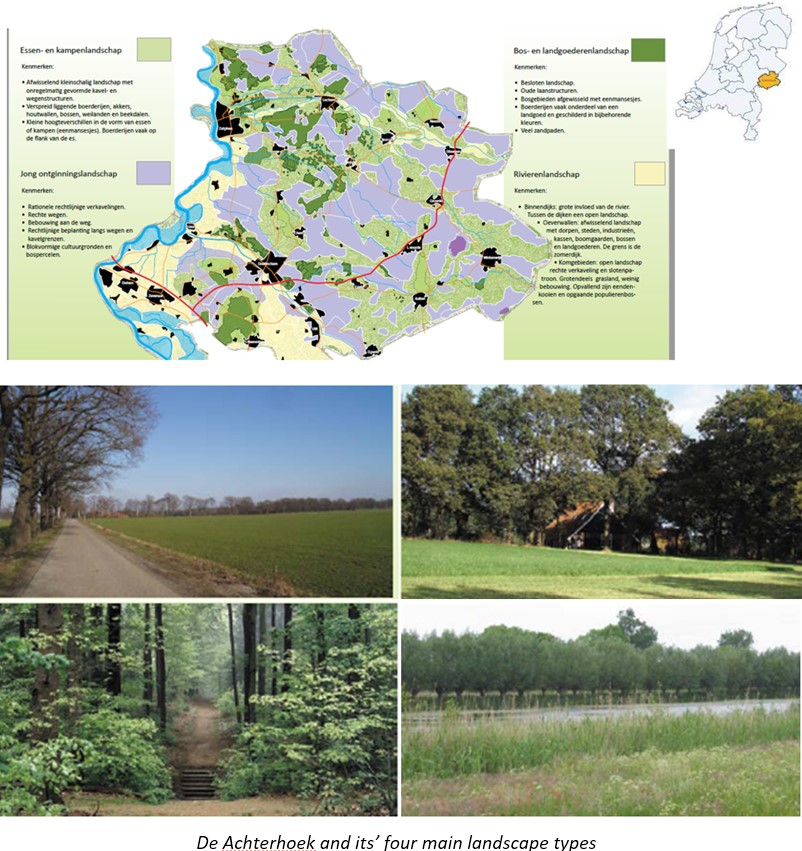4. LIVING LABS FRIESLAND AND GELDERLAND, THE NETHERLANDS
4. Living Labs Friesland and Gelderland, The Netherlands
4.1 Living Lab Peatland Area Friesland
Contact: Peter van der Maas: peter.vandermaas@hvhl.nl
Van Hall Larenstein University of Applied Sciences, Leeuwarden, the Netherlands
4.1.1 Description of the area

The province of Friesland, located in the North of The Netherlands, originally has a distinctly agricultural character. The province is best known for livestock farming and the associated dairy industry. Tourism, especially on the lakes in the southwest of the province and on the Wadden Islands, is an important source of income in the summer. The Frisian peat-meadow area is predominantly located in the central and southwestern part of the province of Friesland. The area of covers about 85,000 hectares, in which grasslands, lakes, nature areas and buildings alternate constantly. This area is one of the last large peatland areas in the Netherlands. Approximately 2000 years ago, most of the western Netherlands consisted of thick peat layers (up to 4 meters above sea level) that had developed over 5000 years due to the accumulation of undigested plant residues. Then around the year 1000 AD, the first attempts were made drain the swampy land, to make the soil ready for agriculture. Through polders, drained land came available for agriculture.
4.1.2 Sustainability issues related to the INVEST themes
a. Water, Energy Food and Environment Nexus
- Reduction of negative effects of subsidence of Peat
- Decreasing the emission of greenhouse gases emissions
- Sustainable perspectives for agriculture
- Climate proof water system
- Natural and cultural heritage preservation
- Green urban and rural environment and quality infrastructure
b. Entrepreneurship.
- New business models and smart technologies
- Regional sustainability and bio-based production
4.2 Living Lab De Achterhoek, Gelderland
Contact: Rik Eweg rik.eweg@hvhl.nl
Van Hall Larenstein University of Applied Sciences, Velp, the Netherlands
4.2.1. Description of the area

‘De Achterhoek’ is a region in the east of the Netherlands, part of the province of Gelderland, with a rich history and tradition. The region is bordered by the rivers Rijn and IJssel and the German border. The region has many castles and estates. The most important cities in de Achterhoek are Doetinchem (45.000 inhabitants) and Zutphen (40.000 inhabitants) the region counts in total 390.000 inhabitants, divided over seven municipalities. The total area is 1467 km2. The largest part (65%) of De Achterhoek is so-called ‘Kampenlandschap’ which is a traditional Dutch landscape, shaped by centuries of agricultural cultivation. An undulating agricultural landscape formed by agricultural arable plots with soils elevated by centuries of cultivation adding plaggen and manure. This landscape is characterized by wooded banks, hedgerows, small winding roads, and old farmyards surrounded by trees.
More recently, in the 19th century, moorlands were cleared and cultivated . This landscape is characterized by straight roads, rectangular parcel and ditches. In the centre of the region large ancient estates can be found. Along the rivers are some clayey lands, riverine terraces and sandy dunes. In the south-east of the area, glacial Pleistocene sands can be found.
4.2.2 Sustainability issues related to the INVEST themes
a. Water, Energy Food and Environment Nexus
- Strengthening biodiversity in the region, in ecosystems and soils
- Stimulating ‘future proof’ food production
- Realization of an attractive agricultural landscape
- Closing (nutrient) cycles
- Societal appreciation of farmers and higher margins for farmers
- Healthy regional food
- Climate mitigation (GHG reduction)
- Reduction of pesticides
b. Quality of Life
- Rural out-migration issues, demography
- Livability for young generations
c. Entrepreneurship
- New business models and smart technologies
- Family business and family business succession/inheritance
- Regional sustainability
- Job creation and human capital management
- Sustainable, regional food production and consumption
4.3 Living Lab Delta East, Gelderland
Contact: Loes Witteveen loes.witteveen@hvhl.nl
Van Hall Larenstein University of Applied Sciences, Velp, The Netherlands
4.3.1 Description of the area
Living Lab Delta East, covers the urbanized river area of Arnhem and Nijmegen where the river Rhine splits into the Waal, Lower Rhine and IJssel. In this area many interests come together, like shipping, mineral extraction, agriculture, urbanization, nature and recreation. And making the river area climate proof so that it can cope with the extremes in water regimes.

Living Lab Delta East provides an arena where complex water related issues of the urbanized fluvial area link to an array of governance, knowledge and communication challenges and the quest for sustainable futures. The challenges in this river area are so complex that no organization or institution can solve them alone. Within the Living Lab approach knowledge institutes, companies, governments and citizens work hand in hand on innovations.
4.3.2 Sustainability issues related to the INVEST themes
a. Water, Food and Environment Nexus
- Flood plain and natural restoration
- Land and Water management
- Restore biodiversity and cut pollution
b. Quality of Life
- Regional sustainable development to reach Sustainable Development Goals
- Livability, safety, sustainability
- Cultural heritage
- Participatory and deliberative governance
c. Enterpreneurship
- Boost the efficient use of resources by moving to a clean, circular economy
- new business models for farming and nature conservation such as wet agriculture
- Metropolitan agriculture: sustainable food production in greenhouses, innovative agriculture like Food Forests and Agro-Forestry, but also leisure and education oriented eco-services.
